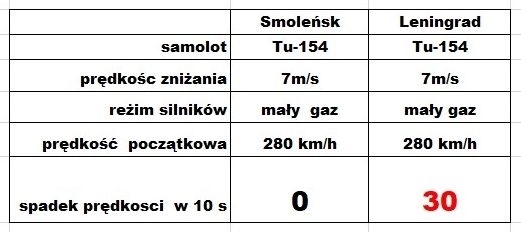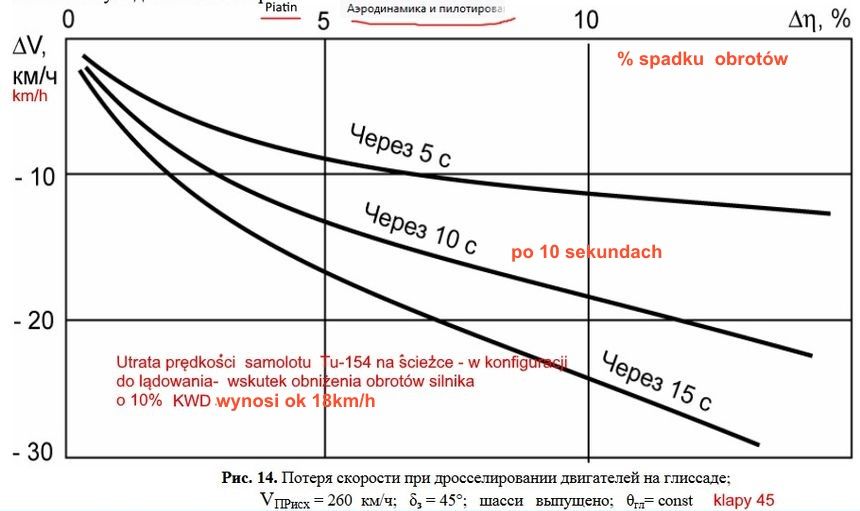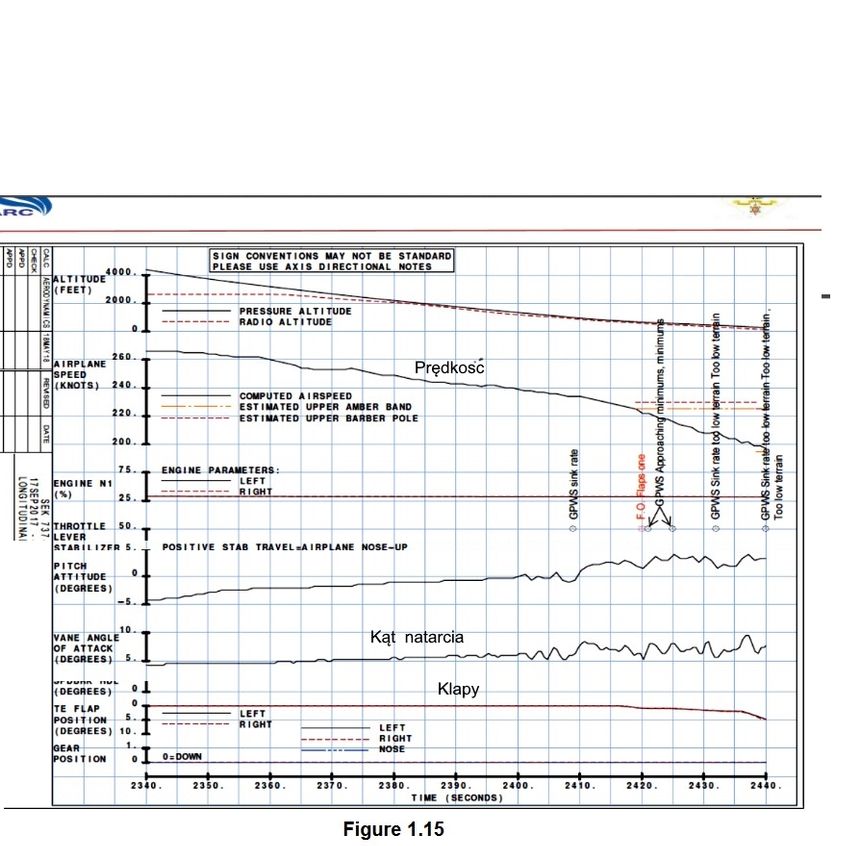Jakim cudem samolot Tu-154 przy minimalnym ciągu silników, zniżając się "po ścieżce" z prędkością opadania rzędu 7m/sek
nie tracił prędkości postępowej ?
Nie trzeba niczego liczyć ; wystarczy porównać:
https://ru.wikipedia.org/wiki/%D0%9A%D0%B0%D1%82%D0%B0%D1%81%D1%82%D1%80%D0%BE%D1%84%D0%B0_%D0%A2%D1%83-154_%D0%B2_%D0%9B%D0%B5%D0%BD%D0%B8%D0%BD%D0%B3%D1%80%D0%B0%D0%B4%D0%B5
Katastrofa Tu-154 w Leningradzie w 1991 roku.
В связи с этим РУДы были установлены на 66%, а штурвал отдан «от себя». Данный манёвр привёл к появлению вертикальной перегрузки 0,9g, длившейся 10 секунд, из-за чего экипаж не заметил возрастание вертикальной скорости снижения, которая возросла до 7 м/с, а скорость полёта упала с 280 км/ч до 250 км/ч.
gdy samolot znajdował sie, na wysokości 60m ..
.. reżim pracy silników ustawiono na 66% i zwiększono kąt pochylenia na zniżanie ; manewr ten skutkował powstaniem przeciążenia 0,9g , które trwało przez 10 sekund , wskutek czego załoga nie zauważyła rosnącej predkości zniżania, która osiagnęła 7m/s a prędkość spadła z 280 km/h do 250 km/h
Zestawienie:

....
Praktyczna aerodynamika:
zgodność teorii z praktyką

Kolejny przykład:
Occurrence Investigation Report SER/002/2017
Jordan Civil Aviation Regulatory Commissionي
AircraftOverranthe Runway during Landing
Boeing 737-300 JY-SOAKing HusseinAirport, Aqaba, Jordan September2017
https://www.carc.jo/images/news/JY-SOA-17-09-2017-RunwayOverrunduringlanding_final.pdf

Ciągły spadek prędkości przy zniżaniu po ścieżce i klapach otwartych na minimum !!
At time 2442 seconds (90 feet radio altitude) the flaps began to extend from flaps 5 towards flaps30 (Figure 1.17)
dopiero na wysokożci 27metrów! rozpoczęto wysuwanie klap na 30.
I kolejny przykład: Airbus A321
na ścieżce ciąg 40% N1 potem 52%N1 - niższy niż wymagany na ścieżce;
spadek prędkości ze 143 do 130 mil/h
https://assets.publishing.service.gov.uk/media/5422f7bfe5274a1314000647/dft_avsafety_pdf_507767
To re-capture the glidepath, the co-pilot reduced engine thrust close to idle (40% N1) and began a descent. During this descent, the co-pilot continued to fly by a mixture of visual and instrument but at 3 nm from touchdown the aircraft was about 300 feet above the glide slope. The aircraft continued to correct towards the glide path and at 950 feet QNH, with the aircraft still just above the glide path, the co-pilot increased power to about 52% N1. He then reduced power again before once more reselecting about 52% N1 a few seconds later. The power then remained at this setting throughout the remainder of the approach until just before landing. The aircraft continued its descent slightly above the glideslope until at 600 feet agl (900 feet QNH) it passed through the glideslope and began to descend slightly below it. During the approach, the aircraft also diverged from the localiser, first to the right and then to the left by about half a dot. The commander called COME RIGHT after the second divergence and the co-pilot immediately corrected the aircrafts track towards the centre line. The approach speed (VAPP) computed by the Flight Management Guidance System and displayed on the PFDs was 143 kts (VREF + 5 kt) which was consistent with the prevailing weather conditions and the aircrafts weight. However, the airspeed began to decay slowly below this value from about 580 feet agl until the aircraft was at about 70 feet agl when the co-pilot called out that the speed was low; by then the airspeed had dropped to 134 kt. The co-pilot advanced the thrust levers before retarding them to idle six seconds later, at or just after touchdown. During this period the increase in engine N1 was 20% but the airspeed continued to decrease and at touchdown it was 130 kts.
I kolejny przykład:
http://code7700.com/accident_bd-700_c-gxpr.htm
At 1434:21 (T-4) and only 680 feet from the threshold, the autothrottle mode changed from the SPEED to the RETARD mode. This caused the thrust levers to automatically retard to the IDLE position. At this point on the approach, there was no recognition by the crew that the aircraft was on an unsafe flight path.
At 1434:23 (T-2) and 360 feet from the threshold, the crew felt the aircraft sinking, and the airspeed decreased to 102 knots.
Od maja 2010 wskazuję na sprzeczność narracji MAK z elementarnymi faktami,śladami oraz prawami fizyki. "Jeszcze nigdy tak niewielu nie stanęło przeciw tak Wielu by bronić prawdy dotyczącej tragicznego zdarzenia lotniczego." "Jeszcze nigdy tak nie skompromitowało się środowisko techników, ekspertów, naukowców milcząc gdy do narzucania kłamliwej narracji łamie się elementarne prawa fizyki i ignoruje wiedzę."
Nowości od blogera
Inne tematy w dziale Polityka

